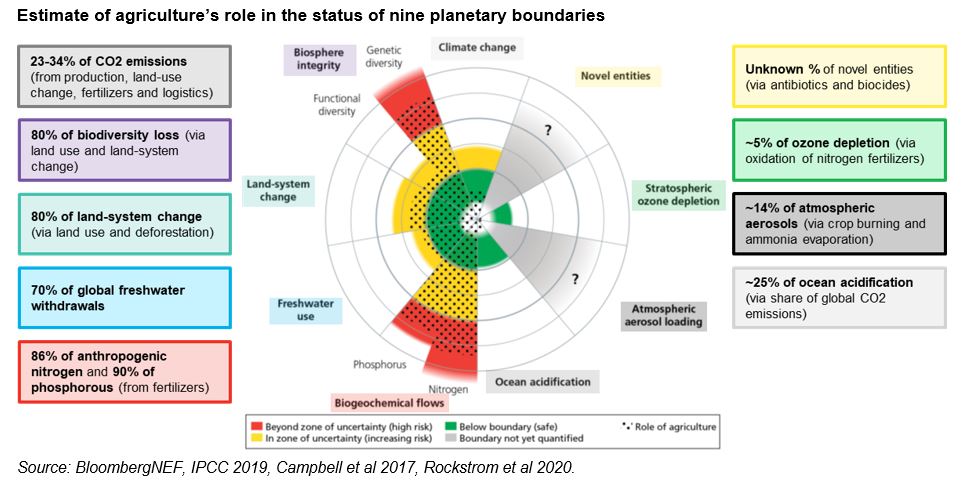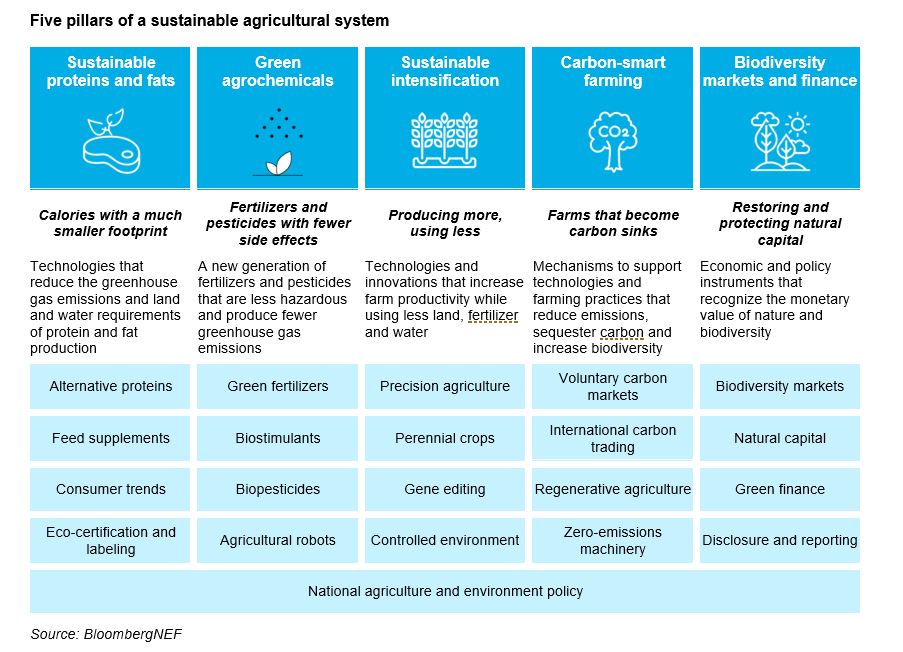By Kobad Bhavnagri, Global Head of Strategy
The global agriculture system is on the verge of a new revolution. Sixty years after the ‘Green Revolution’ brought abundant food supplies to the world, the way food and fiber is produced on the farm is about to undergo another era of sweeping change.
The transformation ahead will shape the future of billions of jobs, trillions of dollars of output and the world’s oldest industry. What’s at stake is whether we have a livable planet, or not.
The planet-sized impact of food
The global agriculture system employs nearly a quarter of the world’s population, generates more than $8 trillion in annual revenue, and occupies and alters over 50% of habitable land on Earth.
That last point reveals the enormous impact that agriculture has on the planet. In fact, of all human industries and activities, agriculture is the single largest driver of threats to the stability of the Earth system due to the number of ‘planetary boundaries’ it breaks. It even trumps our fossil-fuel-dependent energy system as the greatest risk to our children inheriting a livable planet.
The nine planetary boundaries are essentially the physical, chemical and biological processes that have kept Earth in a Goldilocks state for the last 12,000 years. According to scientists’ best estimate, we are currently breaching six of these nine boundaries and agriculture is a major reason for at least four of these transgressions. It is propelling 80% of biodiversity loss, 80% of land-system change and 70% of freshwater withdrawals – among other things.

Four chief culprits
There are four chief culprits behind the outsized impact of the agricultural system – the overuse of land, water, fertilizers and pesticides.
The excessive deployment of these resources is driving the biodiversity crisis, which rivals the climate crisis in both severity and risk. The agricultural sector is also responsible for as much as 34% of global greenhouse gas emissions when following the trail from farm to fork to landfill.
The grand challenge for agriculture is to transform to meet three key goals. It must halt and reverse its contribution to the biodiversity crisis by 2030, as laid out in the Global Biodiversity Framework adopted at the COP15 Summit in Montreal, and become carbon neutral by 2050, as required by the Paris Agreement. And all of this needs to be achieved while still scaling up production to feed an estimated 10 billion people that will populate the planet by mid-century.
How can this possibly be done?
Five pillars of a sustainable food system
BloombergNEF’s research indicates that there are five broad solutions to agriculture’s conundrum, ranging from developing sustainable proteins and fats with a smaller environmental footprint, to using greener agrochemicals.

Sustainable proteins and fats
Producing protein and fat in a more sustainable way is the most substantial challenge for the food system. The core obstacle to overcome is how to produce protein using much less land and with near-zero greenhouse gas emissions.
An often-cited fix is feed supplements, which are an important tool to reduce emissions, but more a radical change to protein production will be necessary to address the other environmental challenges. Plant-based proteins, cultured or lab-grown meats and precision fermentation are all promising candidates. The behavior and acceptance of consumers will be definitive in determining how much of an impact these technologies will have.
Green agrochemicals
The future food system will undoubtedly continue to need agrochemicals like fertilizers, pesticides and herbicides to enable high-yield farming. But these chemicals will need to be made and used with fewer side effects.
A new generation of fertilizers and pesticides that are less environmentally hazardous and produce fewer greenhouse gas emissions is under development. This includes the manufacture of fertilizers via green hydrogen, biostimulants that help plants better absorb nutrients and improve plant health, and biopesticides and other genetic innovations that improve the targeting of pesticides. More advanced agricultural machinery and the application of artificial intelligence will also have a key role to play.
Sustainable intensification
A variety of technologies and innovations are also under development to increase farm productivity and yields, while using less resources. These will be essential to scaling up production to feed billions of increasingly affluent people.
Perennial crops are a notable example. These are a new generation of plants that grow and yield grain for several years, rather than dying after one season, making them more drought and stress resilient, more tolerant of pests, able to store more carbon and better able to access nutrients. Gene editing technologies will almost certainly continue to support productivity improvements, and precision agriculture technologies and approaches will also help to maximize yields, while reducing inputs.
Carbon-smart farming
There are a variety of land management practices, such as regenerative agriculture and agroforestry, that can help sequester carbon in the soil, improve soil health, boost on-farm biodiversity and increase crop resilience. The challenge is in scaling implementation. Farmers need to get paid to overcome the risk of changing practices and meet upfront costs. Carbon markets are the most obvious way to do this. Business model innovations, new methodologies and rising prices for carbon units will all be important for creating more opportunities for farmers.
Biodiversity markets and finance
Protecting 30% of land and sea by 2030 will require an end to agriculture and fishery expansion, the incorporation of more biodiversity on farms, and a reduction in the current footprint of conventional agriculture to create space for the restoration of nature.
The key to achieving this will be money. Nature’s services must be valued if they are to be protected and sustainably managed. A variety of approaches are being developed to help do this. These include biodiversity credit markets, disclosure and reporting frameworks like the Taskforce on Nature-related Financial Disclosures, target-setting regimes, natural capital accounting frameworks and changes to banks’ valuation methods to recognize the essential services provided by nature.
Policy reform
Policymakers will be key to nurturing new technologies and practices, and also scaling back the more than $500 billion of annual subsidies that go to agricultural activities that are harmful to the environment. But as with the journey to net-zero emissions, reorienting a core part of the global economy will require overcoming vested interests and ensuring a just transition for affected communities.
Navigating the transition ahead
Confronted with a need to address emissions, biodiversity loss, changing consumer preferences and potentially disruptive new technology, agricultural supply chains will undergo vast transformations over the coming decades. With those changes come significant threats to the products and business models of sluggish incumbents, but also opportunities for more nimble and innovative players to create trillions of dollars of new value.
BNEF will be producing an array of in-depth research on all of the topics outlined above, unpacking the exciting possibilities of the revolution ahead. We will be looking across the spectrum of agriculture – at everything from crop and livestock production to aquaculture and fisheries, and forestry for food and non-food products.
Read the full article here.
Subscribers can learn more about the five pillars of a sustainable agricultural system and find our suite of Sustainable Agriculture research here.





